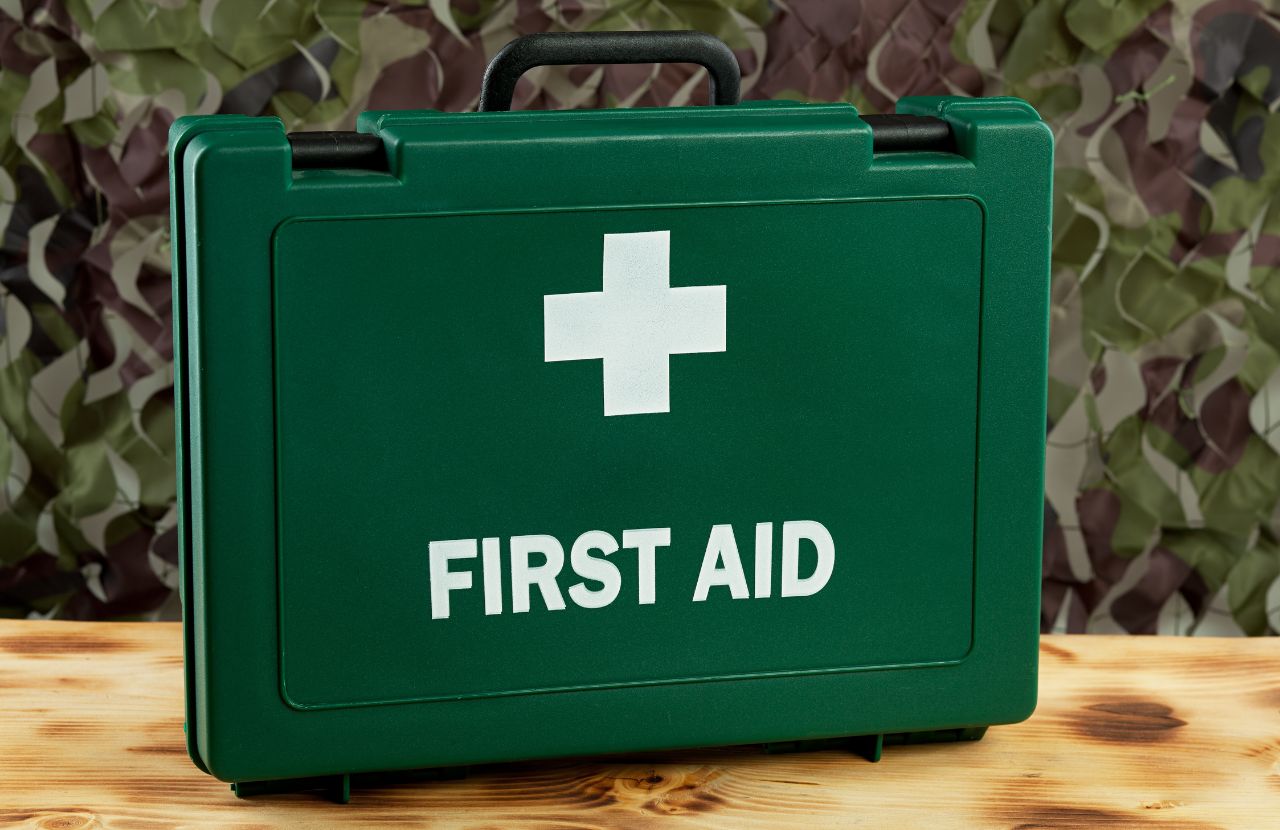
This guide outlines what employers must do to comply with the Health and Safety (First-Aid) Regulations 1981.
Being prepared to administer first aid in the workplace is vitally important. Without first aid a small incident can rapidly develop into a serious situation and put people’s lives at risk.
What are an employers’ responsibilities under the Health and Safety (First-Aid) Regulations 1981?
Employer responsibilities for first aid and providing medical attention are covered by the Health and Safety (First-Aid) Regulations 1981.
Under the regulations, employers must:
- Ensure that employees who are injured or taken ill in the workplace receive immediate medical attention;
- Conduct a first aid assessment of the workplace;
- Provide first aid training to employees;
- Provide adequate first aid facilities, equipment and personnel.
Employers are not legally required to provide first aid to non-employees such as members of the public, but the Health and Safety Executive recommends making first aid provision for non-employees.
Employers should carry out a first aid needs assessment to understand the level of first aid provision required at a workplace. The assessment should cover the particular circumstances of the workplace and the health and safety risks.
Areas to consider include:
- The type of work the organisation does.
- The hazards and risks in the workplace.
- The size and work patterns of the workforce.
- The distribution of the workplace.
- Previous accidents at the organisation.
- Holidays and other absences of first aiders and appointed persons.
- The needs of remote, travelling and lone workers.
- Employees working on shared or multi-occupied sites.
- The distance of the organisation from emergency medical services.
- First aid provision for non-employees.
The Health and Safety Executive provides a useful checklist for first-aid needs assessments and assessment case studies for different types of organisations.
Employee’s responsibilities
Although employees do not have specific duties for first aid in the workplace under the law, the Health and Safety Executive recommends informing their employer of any health issues that should be considered during a first aid needs assessment.
If an employee needs to take medication, such as a spray for angina or an inhaler for asthma, employers can ensure first aiders receive relevant training should the employee become ill at work.
First aiders
There are different types of first aid personnel with different training levels and responsibilities:
- First aid appointed person (FAAP).
- Emergency first aid at work (EFAW) trained first aider.
- First aid at work (FAW) trained first aider.
The Health and Safety Executive advises that, as a minimum, a small office with low health and safety risks needs a first aid box and an appointed person to look after first aid arrangements such as calling an ambulance. Whereas a workplace with greater health and safety risks is likely to need one or more trained first aiders.
First aid appointed person (FAAP)
A first aid appointed person is someone designated within the workplace to take charge in case of an emergency. They do not need formal first aid training, but they should have basic knowledge of first aid principles and know where the first aid equipment is located.
Their role is to look after first aid equipment, call the emergency services if required and provide initial assistance until trained first aiders or medical professionals arrive. Learn more about the main responsibilities of an appointed person with our expert guide.
Our online First Aid Appointed Person training course supports appointed persons to understand their responsibilities and carry out their role competently. It covers what to do in an emergency, including training on using first aid equipment, administering CPR, and calling the emergency services.
EFAW trained first aider
An EFAW trained first aider has completed a one-day Emergency First Aid at Work course, which is designed to provide basic first aid skills. They can provide immediate assistance in the event of injuries or medical emergencies.
EFAW trained first aiders may administer first aid for minor injuries and help stabilise a person’s condition until further medical help arrives.
FAW trained first aider
An FAW first aider has undergone a more comprehensive three-day First Aid at Work course. They have a deeper understanding of first aid techniques and can handle a wider range of injuries and illnesses.
FAW trained first aiders are equipped to provide first aid for more serious injuries and to manage emergency situations until professional medical assistance is available.
Refresher and additional training
The Health and Safety Executive recommend that first aiders undertake annual refresher training.
It is also useful for first aiders and other employees to undergo training in preventing accidents from happening in the first place. Slips, trips and falls are the main cause of injuries in the workplace, and our slips, trips and falls training course helps raise employee awareness to prevent accidents.
Our Office Safety training course helps ensure employees can identify workplace hazards and know how to report incidents and potential safety issues.
Number of first aiders required
A first aid needs assessment will help you determine what level of training your first aiders require and how many first aiders you need at work.
There are no set rules on exactly how many trained first aiders or appointed persons an organisation should have, but the Health and Safety Executive recommends the following numbers based on the environment and hazard level:
Low-hazard workplaces such as offices, shops and libraries:
- Fewer than 25 employees: At least one appointed person.
- 25–50 employees: At least one first-aider trained in EFAW.
- More than 50 employees: At least one first-aider trained in FAW for every 100 employed (or part thereof).
Higher-hazard workplaces including light engineering and assembly work, food processing, warehousing, extensive work with dangerous machinery and construction:
- Fewer than 5 employees: At least one appointed person.
- 5–50 employees: At least one first-aider trained in EFAW or FAW depending on the type of injuries that might occur.
- More than 50 employees: At least one first-aider trained in FAW for every 50 employed (or part thereof).
Choosing first aiders
Ideally it is best to request volunteers to take on a first aid role and choose people who have the following qualities:
- Calmness. First aiders should remain calm and composed, even in stressful and emergency situations.
- Empathy and compassion. Having empathy and showing kindness towards the injured or ill person helps create a sense of trust and comfort.
- Communication skills. Effective communication is vital for assessing the situation, conveying instructions, and obtaining necessary information from the casualty and bystanders.
- Quick thinking. First aiders must think on their feet and make rapid decisions to provide timely care and potentially life-saving interventions.
- Medical emergencies vary, so first aiders should be adaptable and able to adjust their approach based on the specific situation and the needs of the casualty.
- In some situations, first aiders may need to take charge and provide clear directions to others, especially in larger-scale incidents.
- Attention to detail. Paying close attention to the casualty’s condition, vital signs, and any changes in their status is essential for providing appropriate care.
- Providing first aid can be physically demanding, so having the physical stamina to perform tasks like CPR or assisting with the movement of injured individuals is important.
These personal skills combined with first aid training enable individuals to be effective and compassionate first aiders who can make a difference in times of need.
Reporting accidents
Under the Reporting of Injuries, Diseases and Dangerous Occurrences Regulations 2013 (RIDDOR) certain workplace accidents, injuries and near-misses must be reported to the Health and Safety Executive. See our article, What is Riddor and why is RIDDOR reporting important?
Accident book
Under the Health and Safety (First-Aid) Regulations 1981 it is a legal requirement for employers to maintain an accident book. The accident book is used to record details of accidents, injuries, and incidents that occur in the workplace. This document can help with identifying patterns of accidents so steps can be taken to prevent future incidents. It also provides evidence for insurance and legal purposes.
Employers are responsible for ensuring the accident book is readily available to employees and that it is used to record accidents and incidents promptly and accurately.
First aid equipment and facilities
The Health and Safety (First-Aid) Regulations 1981 require that employers provide “adequate and appropriate” first-aid equipment and facilities. A first-aid needs assessment will decide how much and what equipment and facilities you need to provide, but at minimum, you should have a first-aid kit with suitable contents. For an organisation with low-risk work activities, the Health and Safety Executive recommend a kit should include the following as a minimum:
- A leaflet with general guidance on first aid;
- 20 individually wrapped sterile plasters of assorted sizes;
- Two sterile eye pad;
- Four individually wrapped triangular bandages, preferably sterile;
- Six safety pins;
- Two large, individually wrapped, sterile, unmedicated wound dressings;
- Six medium-sized, individually wrapped, sterile, unmedicated wound dressings;
- At least three pairs of disposable gloves.
All organisations must inform employees of first aid arrangements. It is usually sufficient to display notices outlining who and where the first aiders or appointed persons are, and where the first aid box is. You should make special arrangements for employees who have reading or language difficulties.
Organisations in high-risk industries such as manufacturing, construction and food processing may need additional equipment and facilities, such as a first aid room used exclusively for first aid.
First aid rooms must be big enough for an examination or medical couch. They should have washable surfaces, hot and cold running water and adequate heating, lighting and ventilation. Rooms should be located as near as possible to a point of access for transport to hospital and have a notice on the door with the names, locations and, if appropriate, contact details for first aiders.
Responsibilities of the self-employed
Self-employed individuals are also required to have “adequate and appropriate” equipment to provide first aid for themselves while at work. They should carry out an assessment of the hazards and risks in their workplace to establish an appropriate level of equipment. For example, those who regularly drive long distances may need a first aid kit in their vehicle.
Although the self-employed are responsible for their first aid provision, the Health and Safety Executive recommends that self-employed people who work in shared premises with others make arrangements for one person to take responsibility for first aid for all workers on the premises. There should be a written agreement for such an arrangement.
If you are self-employed, our First Aid Appointed Person course will equip you with the skills and knowledge you need to ensure you to feel confident in an emergency.





